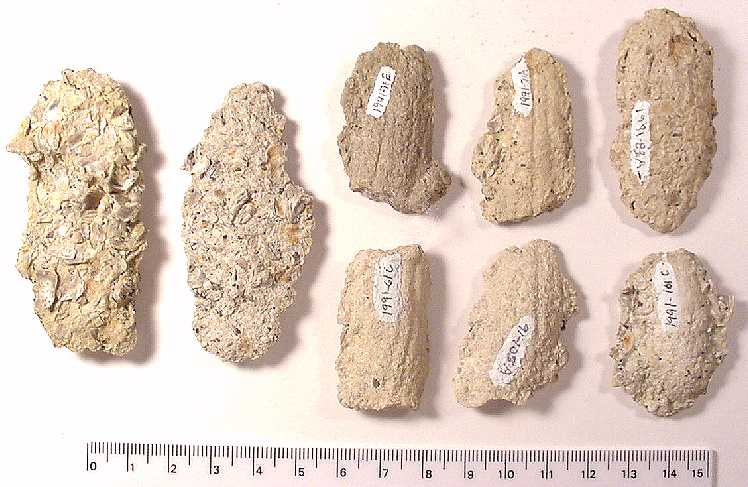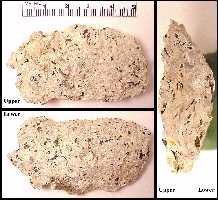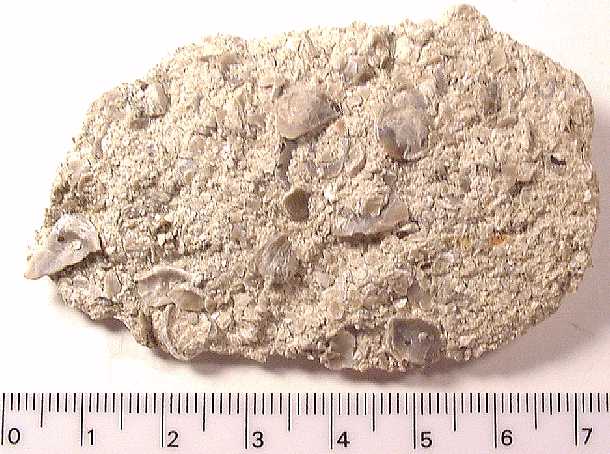
Kansas Academy of Science, Transactions 11(Abstracts):12.
Copyright © 2001-2009 by Mike Everhart
Last update: 03/26/2009
LEFT: Oyster shell concentrations from the Smoky Hill Chalk (Late Coniacian) of Gove County, Kansas. Scale = mm
 |
OYSTER-SHELL COPROLITES; A STRATIGRAPHIC MARKER IN THE
SMOKY HILL CHALK (UPPER CRETACEOUS) OF WESTERN KANSAS Kansas Academy of Science, Transactions 11(Abstracts):12. Copyright © 2001-2009 by Mike EverhartLast update: 03/26/2009
LEFT: Oyster shell concentrations from the Smoky Hill Chalk (Late Coniacian) of Gove County, Kansas. Scale = mm |
ABSTRACT: Elongate ovoidal fossil structures composed almost entirely of broken shell fragment attributable to the epizootic oyster Pseudoperna congesta occur within a limited stratigraphic interval in the lower Smoky Hill Chalk Member, Niobrara Chalk of Western Kansas. More than seventy of these shelly structures have been examined to date. The structures average 42 mm in length by 26 mm in width and are less than 10 mm thick at the center. The stratigraphic interval containing these structures is a laminate olive gray chalk, approximately three meters in thickness which lies between Marker Units 4 and 5 in the composite section of Hattin (1982). The interval also corresponds to the lower portion of the biostratigraphic zone of Spinaptychus n. sp. proposed by Stewart (1990). Chalk in this area is of late Coniacian age and was deposited about 85 million years ago. Although these structures are similar in shape to some of the sand filled shrimp burrows that are found as fossils in the Mooreville Chalk of Alabama, there are significant differences. These shelly structures may be the coprolites from an as yet unknown predator that fed on colonies of oysters in the Western Interior Sea during the late Cretaceous. Nodules found in the Cretaceous (Turonian) of Greenland containing pieces of Inoceramid shell have been interpreted as coprolites of the shell crushing shark Ptychodus by Hoch (1991). Regardless of their origin, the stratigraphically limited occurrence of these structures is a useful marker for determining the relative age of fossils found in the lower Smoky Hill Chalk.
(Unpublished paper follows - Please do not cite or quote):
Introduction
The Smoky Hill Member of the Niobrara Chalk of western Kansas was deposited as marine sediments in the Western Interior Sea that covered the central United States during the late Cretaceous period, 82 to 87 million years ago. The formation lies conformably between the Fort Hays Member of the Niobrara Chalk and the Sharon Springs Member of the Pierre Shale, and is about 180 meters (600 feet) in thickness (Hattin, 1982). It has been a haven for fossil hunters for over a hundred years and has been the source of many spectacular marine fossils. Unfortunately, most of the fossils taken from the chalk during this time were not associated with good stratigraphic or locality data, and their relative scientific value is therefore somewhat diminished.
Early workers attempted to divide the formation on the basis of the fossils which had been found in it. Logan (1897) referred to the entire Smoky Hill Member as the "Pteranodon" Beds. Williston (1897) further sub-divided the Pteranodon Beds into the "Hesperornis Beds" and the "Rudistes Beds" on the basis of the marine bird, Hesperornis, found in the upper chalk and the rudist, Durania maxima, found in the lower chalk. Williston (1897) also commented that "I need not call the attention of future collectors to the importance of locating the horizon of specimens more accurately than has been done before." Despite that admonition, few collectors in the chalk since then have been able to document the stratigraphic location of their finds.
More recently, several authors have attempted to describe the stratigraphic sequences within the Smoky Hill Chalk. Others, such as Bardack (1965) and Stewart (1978, 1988, 1990) have added observations on the biostratigraphy, noting where certain species were or were not found. Hattin (1982) published the most complete description to date of the stratigraphy and invertebrate biostratigraphy of the Smoky Hill Chalk, dividing the chalk on the basis of 23 distinct marker units. Stewart (1990) incorporated these marker units into his interpretation of the vertebrate biostratigraphy of the Smoky Hill Chalk. Considered together, these works represent the beginnings of a reliable methodology for determining the actual horizon for fossils collected in the chalk. Problems are encountered when Hattin's (1982) Marker Units are not readily visible or identifiable in some exposures. Stewart's (1990) biostratigraphy relies on the collection and accurate identification of vertebrate and invertebrate fossils, some of which are not easily found in all localities. Additional work is needed to further describe and refine the details of the stratigraphy, and to determine the temporal ranges of the vertebrates and invertebrates. This paper provides an additional and reliable marker to the stratigraphy of the lower section of the chalk.
Discussion
During 1990 and 1991, intensive collecting was done in the lower one third of the Smoky Hill Member, Niobrara chalk of western Kansas in an attempt to validate both Hattin's (1982) stratigraphy and Stewart's (1990) biostratigraphy. As a result, small, oval fossil structures or masses consisting predominantly of broken shells of the epizootic oyster, Pseudoperna congesta, were collected from a limited stratigraphic interval (Everhart and Everhart, 1992). Over three hundred of these oyster shell containing structures from 5 separate localities have been examined to date.
The strata which produces these shell filled structures is approximately 4 meters in thickness and is located at an elevation of between 35 and 39 meters (115-128 feet) above the base of the Smoky Hill member in the composite section of Hattin (1982). The interval is roughly bounded by Marker Unit 4 and Marker Unit 5 as proposed by Hattin (1982) and is probably of late Coniacian age. If the average deposition rate of 0.036 mm per year (2.5 cm / 1 inch per 700 years) suggested by Hattin (1982) is valid, then the depositional period that contains these structures would have lasted about 100 thousand years.
| This picture shows an outcrop of the Smoky Hill Chalk in Gove
County, KS. where Marker Unit 4 and Marker Unit 5 are both exposed. They occur near the
dividing line between the biostratigraphic zones of Protosphyraena perniciosa and
Spinaptychus n. sp.. This elevation also marks the approximate boundary between
the upper-most Coniacian and lower-most Santonian ages of the late Cretaceous. Biostratigraphically, these shell masses are found in association with the large bivalves Volviceramus grandis and Platyceramus platinus, and are several meters below the first occurrence of the bivalve Cladoceramus undulatoplicatus. The proposed marker interval also corresponds with the lower portion of Stewart's (1990) Zone of Spinaptychus n. sp and lies just above his Zone of Protosphyraena perniciosa. The actual dividing line between these two biostratigraphic zones is still being defined and some overlap is expected. |
 |
 |
Typically, these shell masses are shaped as elongate, flattened
ovals. The structures average 42 mm in length by 26 mm in width and are usually less than
10 mm thick at the center. Generally, the shell masses are found lying on the surface of
the chalk where they have weathered out. Typically, they are completely eroded from the
chalk, and do not appear to be connected with other fossilized material. The lower side is
always smooth and convex, with longitudinal striations on about 25% of those examined. The
upper surface is rough (eroded?) in texture and is composed of a compacted mass of
randomly arranged, sharp edged shell fragments. No preferential sorting of the fragments
has been noted. LEFT: Upper and lower views, and a cross-section of a fairly typical oyster shell structure (30 mm x 51 mm - 10 mm thick). Click her for a larger version of the cross-section. |
 |
(LEFT: upper side of an oyster shell concentration. Scale in mm) These structures are made up almost entirely of shell fragments from the epizootic oyster Pseudoperna congesta with single, small pieces of juvenile inoceramid shell occurring in less than 20% of the shell masses examined. The oyster shell fragments contained in these masses are fairly uniform in size within each of the individual masses and are sharp edged and angular. |
In overall shape and size, the structures resemble some of the fossilized shrimp burrows (Thalassinoides) that are found in the Mooreville Chalk of Alabama. There are, however, significant differences. The burrows are composed of compacted sand and other bottom debris that was winnowed from the sediments while the cavity was occupied by the shrimp. Hattin (1991, personal communication) believes that the shell structures are also similar to the fossilized burrows that occur just below the Smoky Hill Chalk - Fort Hays Limestone contact, and the Thalassinoides burrows in the Dakota Sandstone and Carlile Shale. However, the shell structures found in the Smoky Hill Chalk show no evidence of sorting and contain none of the bone fragments, teeth or other debris that would be expected if they had been the result of winnowing of benthic sediments.
According to Hattin (1982), the stratigraphic interval in which the structures occur is a laminated olive gray chalk that shows little or none of the bioturbulation that would be expected if conditions in the sediments had been conductive to burrowing invertebrates such as shrimp. It is likely that the bottom muds were oxygen poor during most of the depositional period and would not have supported even a moderately diverse community of burrowing invertebrates.
The size and appearance of these fossil structures strongly suggests coprolitic origin. Stewart (personal communication, 1990) initially proposed that these oyster shell structures are coprolites. They are contemporaneous with the well preserved, spiral shaped coprolites of presumed shark origin described by Stewart (1978). If the masses are, in fact, coprolites, then they would offer direct evidence of selective predation on the prolific oyster communities that utilized the large inoceramid bivalves (V. grandis and P. platinus) as substrates. These bivalves apparently offered the only hard stands in an otherwise soft mud bottom and can be found with as many as four generations of oysters coating the outer surfaces of both valves (Hattin, 1982).
Kauffman (1972) reported on evidence of Ptychodontid shark tooth marks on inoceramid shells. However, no such remains were found in the study area. Hoch (1991) has interpreted the numerous oblong nodules found in the late Turonian mudstones of Greenland which contain inoceramid fragments as coprolites of Ptychodontid sharks. While the author has also found a few shelly masses consisting of thin layers of small inoceramid fragments, there is insufficient evidence at this point to conclude that these structures may also be coprolites.
The numerous fossilized remains of the Pseudoperna congesta communities attached to inoceramid bivalves and other invertebrates indicate that these oysters were the most common epizoans of the period. As such, they would have represented a readily available food source and it is likely that both vertebrate and invertebrate predators were feeding on them.
Additional work needs to be done to determine if evidence of damage attributable to predation can be found on the fossilized remains of the oyster colonies. Some damage to small inoceramid shells has been found which suggests feeding on the attached oysters. This may not be conclusive, however, since the shell material contained in the masses may consist of primarily the upper, free valve of the oyster, or the damage to the oysters may have been overgrown by succeeding generations.
In proposing such a predator-prey relationship, the question remains as to the identity of the predator. The pavement toothed shark, Ptychodus sp., is regarded as a shell crushing predator but as yet no coprolitic material has been positively associated with the remains of this genus in the Smoky Hill Chalk or elsewhere. In addition, Ptychodus teeth are found in pre-Niobrara deposits and at least one species (Ptychodus mortoni) is extant in the fossil record up to Hattin's Marker Unit 10 (Stewart, 1990). Pseudoperna congesta is found throughout the Smoky Hill Chalk. This is in contrast to the limited stratigraphic occurrence of these shell-filled masses.
Modern fishes such as rays and drums, as well as some other marine fish feed on oysters and shellfish. According to Schäfer (1972), the North Sea Wolf fish, Anarhichias lupus and A. minor feed on gastropods, lamellibranchs and crustaceans, and ingest the calcium carbonate shell material along with the soft bodies of their prey. The coarse and sharp edged fragments that result from the grinding of the heavy shells pass unchanged through the intestinal canal and are eliminated as feces. Schäfer (1972) concludes that the fish has no acidic gastric juices to cause even partial dissolution of the shell material. He further states that this is apparently an adaptation to the extremely large quantities of ingested calcareous material which would neutralize gastric juices unless they were produced in excessive quantities.
Martinichthys is a rare and relatively obscure plethodid which was first described by McClung (1926) and recently re-described by Taverne (1999). Earlier workers, including Cope (1877) and Hay (1903), had mistakenly assigned the fragmentary and enigmatic remains to the genus Protosphyraena. This genus occurs only in the lower Smoky Hill Chalk, has been found only in Kansas, and is found only in the interval between Marker Units 4 and 5 (Everhart and Everhart, 1993). This genus is represented, at best, by a two fragmentary skulls (KUVP 497 and KUVP 498) and associated vertebrae, and by more numerous, isolated rostra in the collections of the University of Kansas, the Sternberg Museum of Natural History, and the author's personal collection.
While these rostra differ in shape, size and surface markings, they all show what appears to be wear on the anterior end. McClung (1926) first noted that the anterior ends of all of his rostra specimens appeared to be beveled at an angle. In the watery mud environment of the Late Cretaceous sea bottom, this sort of wear could only have been caused by the fish persistently grinding or pounding the end of its snout against some hard or abrasive surface. The only such hard substrate on the sea bottom during this time were the inoceramid bivalves and the colonial oysters that covered them, and the rudist, Durania maxima. The evidence for this kind of a predator-prey relationship is, at best, circumstantial but continues to be the subject of further investigation.
Conclusion
Regardless of the exact origin of these structures, their limited stratigraphic occurrence is a useful marker in determining the relative age and temporal relationship of other vertebrate and invertebrate remains found in the lower chalk.
References Cited:
Bardack, D., 1965. Localities of fossil vertebrates obtained from the Niobrara Formation (Cretaceous) of Kansas. University of Kansas Publications, Museum of Natural History 17(1):1-14.
Cope, E. D.
, 1877. On the genus Erisichthe. Bull. U. S. Geol. and Geog. Surv. iii, article xx. pp. 821-823.Everhart, M. J. and P. A. Everhart, 1992. Oyster-shell concentrations; a stratigraphic marker in the Smoky Hill Chalk (upper Cretaceous) of western Kansas. Kansas Acad. Sci. Trans., 11(Abstracts):12.
Everhart, M. J. and P. A. Everhart, 1993. Notes on the biostratigraphy of the plethodid Martinichthys in the Smoky Hill Chalk (upper Cretaceous) of western Kansas. Kansas Acad. Sci. Trans., 12(Abstracts):36.
Hattin, D. E., 1982. Stratigraphy and depositional environment of the Smoky Hill Chalk Member, Niobrara Chalk (Upper Cretaceous) of the type area, western Kansas. Kansas Geological Survey Bulletin 225, 108 pp.
Hay, O. P., 1903. On certain genera and species of North American Cretaceous actinopterous fishes. Bull. Amer. Mus. Nat. Hist. XIX 1-95, pls. i-v, 72 text-figs.
Hoch, E., 1991. Palaeontological data on life in the intra-cratonic Kangerdlugssuaq basin. Kangerdlugssuaq Studies - Processes at a rifted continental margin - Proceedings. pp. 45-51.
Kauffman, E. G., 1972. Ptychodus predation upon a Cretaceous Inoceramus. Palaeontology, 15(3):439-444.
Logan, W. N., 1897. The upper Cretaceous of Kansas; with an introduction by Erasmus Haworth: Kansas Geological Survey, Vol.2, p. 195-234
McClung, C. E., 1926. Martinichthys, a new genus of Cretaceous fish from Kansas, with descriptions of six new species. Proc. Amer. Philos. Soc. 65 no. 5, (suppl.) 20-26, 2 pls.
Schäfer, W. 1972. Ecology and palaeoecology of marine environments. C. Y. Craig, Ed. The University of Chicago Press, 568 pp.
Stewart, J. D., 1978. Enterospirae [fossil intestines] from the upper Cretaceous Niobrara Formation of western Kansas. Univ. Kansas Paleon. Contri., 89:9-16.
Stewart, J. D., 1988. The stratigraphic distribution of late Cretaceous Protosphyraena in Kansas and Alabama, Geology, In Nelson, M. E. (ed.), Paleontology and biostratigraphy of western Kansas: Articles in honor of Myrl V. Walker, Fort Hays Studies, 3(10):80-94. (Science).
Stewart, J. D., 1990. Niobrara Formation vertebrate stratigraphy, pages 19-30, In Bennett, S. C. (ed.), Niobrara Chalk Excursion Guidebook, The University of Kansas Museum of Natural History and the Kansas Geological Survey.Taverne, L., 1999. Révision du genre Martinichthys, poisson marin (Teleostei, Tselfatiirormes) du Crétecé supérior du Kansas (États-Unis). Geobios 33(2):211-222.
Williston, S. W., 1897. The Kansas Niobrara Cretaceous, The University Geological Survey of Kansas, 2:237-246.
Martinichthys: A Mystery Fish from the Smoky Hill Chalk
Notes of the occurrence and distribution of the rare plethodid fish, Martinichthys
